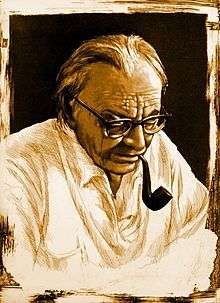Trionfo di Afrodite
| Trionfo di Afrodite | |
|---|---|
| Scenic cantata by Carl Orff | |
 | |
| Description | concerto scenico |
| Translation | Triumph of Aphrodite |
| Language |
|
| Based on | wedding poems by Catullus, Sappho and Euripides |
| Premiere |
23 March 1953 La Scala, Milano |
Trionfo di Afrodite (Italian, literally Triumph of Aphrodite) is a cantata called "concerto scenico" (scenic concert) written in 1951 by the German composer Carl Orff. It is part of Trionfi, the musical triptych that also includes Carmina Burana and Catulli Carmina. In this case, "Trionfo" refers to the Roman and Renaissance trionfo, meaning "procession" or "festival". Trionfi was premiered in 1953 at La Scala in Milano, conducted by Herbert von Karajan.
Like Igor Stravinsky's Les Noces, Trionfo di Afrodite describes rituals for a (in this case Greek-Roman) wedding. The texts are based on Latin wedding poems by Catullus, as well as Greek poems by Sappho and a small part by Euripides. Despite the large orchestra, the instrumentation is often sparse, especially in the Greek verses, and the music is strongly influenced by the rhythms and melodies of the spoken word,[1] though little importance is actually given to both tonic and prosodic accent. The piece closes with a triumphant apparition of Aphrodite herself, a rare instance when the full choral and orchestral forces are actually used.
Apart from the orchestra, the piece calls for five soloists (SSTTB) and a large mixed chorus.
Structure
The work is divided into seven parts:
- Antiphon of the virgins and young men
- Wedding procession and arrival of the bride and groom
- Bride and groom
- Invocation of Hymenaios - hymn to Hymenaios
- Games and wedding songs in front of the wedding chamber
- Song of the newlyweds from the wedding chamber
- Apparition of Aphrodite
Orchestra
The work calls for a large orchestra with an enhanced percussion section, consisting of the following:
- Woodwind
- 3 Flutes (all 3 doubling Piccolos)
- 3 Oboes (2nd and 3rd doubling English Horns)
- 3 Clarinets in B-flat
- 3 Bassoons (3rd doubling Contrabassoon)
- Percussion (requiring 10-12 players, not counting Timpani)
- 6 Timpani
- 4 Standard Cymbals (2 suspended, 1 pair crash)
- Tam-Tam
- Tubular bells
- Tambourine
- 2 Snare Drums
- 2 Bass Drums
- 4 Maracas
- 4 Wood blocks
- 3 Glockenspiels
- Xylophone
- Marimba
- Tenor Xylophone
- Strings
- Violins I (12-14)
- Violins II (12-14)
- Violas (12)
- Violoncellos (12)
- Double basses (8)